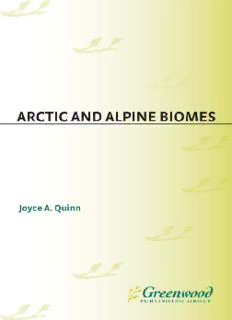
Arctic and Alpine Biomes (Greenwood Guides to Biomes of the World) PDF
Preview Arctic and Alpine Biomes (Greenwood Guides to Biomes of the World)
Arctic and Alpine Biomes GREENWOOD GUIDES TO B W IOMES OF THE ORLD IntroductiontoBiomes SusanL.Woodward TropicalForestBiomes BarbaraA.Holzman TemperateForestBiomes BerndH.Kuennecke GrasslandBiomes SusanL.Woodward DesertBiomes JoyceA.Quinn ArcticandAlpineBiomes JoyceA.Quinn FreshwaterAquaticBiomes RichardA.Roth MarineBiomes SusanL.Woodward Arctic and A L P I N E B I O M E S JoyceA.Quinn GreenwoodGuidestoBiomesoftheWorld SusanL.Woodward,GeneralEditor GREENWOODPRESS Westport,Connecticut•London LibraryofCongressCataloging-in-PublicationData Quinn,JoyceAnn. Arcticandalpinebiomes/JoyceA.Quinn. p.cm. Includesbibliographicalreferencesandindex. ISBN978–0–313–33840–3(set:alk.paper)—ISBN978– 0–313–34017–8(vol.:alk.paper) 1.Tundraecology.2.Tundraecology—Arcticregions.3. Mountainecology—AlpsRegion.4.Alpineregions.I.Title. QH84.1.Q562008 577.5086—dc22 2008027510 BritishLibraryCataloguinginPublicationDataisavailable. Copyright(cid:2)C 2008byJoyceA.Quinn Allrightsreserved.Noportionofthisbookmaybe reproduced,byanyprocessortechnique,withoutthe expresswrittenconsentofthepublisher. LibraryofCongressCatalogCardNumber:2008027510 ISBN:978–0–313–34017–8(vol.) 978–0–313–33840–3(set) Firstpublishedin2008 GreenwoodPress,88PostRoadWest,Westport,CT06881 AnimprintofGreenwoodPublishingGroup,Inc. www.greenwood.com PrintedintheUnitedStatesofAmerica Thepaperusedinthisbookcomplieswiththe PermanentPaperStandardissuedbytheNational InformationStandardsOrganization(Z39.48–1984). 10 9 8 7 6 5 4 3 2 1 Contents Preface vii HowtoUseThisBook ix TheUseofScientificNames xi Chapter1. IntroductiontoArcticandAlpineBiomes 1 Chapter2. ArcticandAntarcticTundra 33 Chapter3. Mid-LatitudeAlpineTundra 83 Chapter4. TropicalAlpineBiome 157 Glossary 201 Bibliography 209 Index 213 v This page intentionally left blank Preface InthecourseoftravelingthroughouttheUnitedStatesandtheworld,Ihavebeen fortunate to experience arctic and alpine environments firsthand. I have visited Lapland and the Land of the Midnight Sun, climbed mountains in the Sierra Ne- vada and the Pyrenees, and hiked over many high passes in the mountains of North America, Europe, and Asia. Walking through a flower-filled meadow and hearingthewhistleofamarmotfromarockpileisatreatforthesenses. Thisbookcanbeonlyanintroductiontoavasttopicthatwouldtakevolumes to thoroughly explore. It covers a small part of the variety in the natural world, much ofwhichisat riskbecauseofhumanactivities,whether purposefulorinad- vertent. A little knowledge of a subject arouses curiosity—a desire to learn more. And as one learns more, the subject takes on greater importance. Conservation issues become more meaningful when the public is aware of the interactions among elements in the natural world. Hopefully, the information in these pages will instill an appreciation for arctic and alpine environments and their natural inhabitants. Instead of seeing individual plants in a botanic garden or animals in captivity,readerswillhaveafeelingforthevalueofeachinitsnaturalplaceinthe world. Arctic and alpine biomes are thecold regions beyond thelimit oftree growth, eitherbecauseoflatitudeorelevation.Thefirstchapterexplainselements,suchas temperature,precipitation,andformsoflife,commontotheArctic,Antarctic,and alpineregions.Italsomentionsdifferences,whichareelaboratedoninsubsequent chapters.SelectedgeographicregionsaredescribedinchaptersdealingwithArctic andAntarctic,mid-latitudealpineenvironments,andtropicalalpineregions. vii viii Preface Textual material is illustrated with numerous maps, diagrams, photographs, andlinedrawings.Theintendedaudienceisnotonlyadvancedmiddleschooland high school students, but also university undergraduates and anyone else who is interestedinthenaturalenvironmentofhighmountains. IwouldliketothankKevinDowningofGreenwoodPressforhisinsightsand constantsupportinthecompletionofthisproject.JeffDixondidamasterfuljobof decipheringmysketchestoproducemeaningfulillustrations.BerndKuenneckeof RadfordUniversity’sGeographyDepartmentpreparedthemapsoftheworldwide distribution of arctic and alpine regions. Several people generously provided pic- tures for the book, while others read drafts and offered suggestions. I am deeply indebted to all individuals who enabled me to finalize this volume. Any errors, however,aresolelymyown. How to Use This Book Thebookisarrangedwithageneralintroductiontoarcticandalpinebiomesanda chaptereachontheArcticandAntarcticTundraBiome,Mid-latitudeAlpineTun- dra Biome, and the Tropical Alpine Environment Biome. The introduction describes unifying characteristics, such as the physical environment of the biome andplantandanimaladaptations.Subsequentchaptersbeginwithageneralover- viewataglobalscaleanddescriptionsoffeaturesspecifictothatbiome.Regional descriptions are organized by the continents on which they appear. Each chapter andeachregionaldescriptioncanmoreorlessstandonitsown,butthereaderwill find itinstructivetoinvestigatethe introductorychapter andthe introductorysec- tions in the later chapters. More in-depth coverage of topics perhaps not so thor- oughlydevelopedintheregionaldiscussionsusuallyappearsintheintroductions. TheuseofLatinorscientificnamesforspecieshasbeenkepttoaminimumin thetext.However,thescientificnameofeachplantoranimalforwhichacommon nameisgiveninachapterappearsinanappendixtothatchapter.Aglossaryatthe end of the book gives definitions of selected terms used throughout the volume. Thebibliographyliststheworksconsultedbytheauthorandisarrangedbybiome andtheregionalexpressionsofthatbiome. All biomes overlap to some degree with others, so you may wish to refer to otherbooksamongGreenwoodGuidestoBiomesoftheWorld.Thevolumeenti- tled Introduction to Biomes presents simplified descriptions of all the major biomes. Italsodiscussesthemajorconceptsthatinformscientistsintheirstudyandunder- standingofbiomesanddescribesandexplains,ataglobalscale,theenvironmental factorsandprocessesthatservetodifferentiatetheworld’sbiomes. ix
Description: